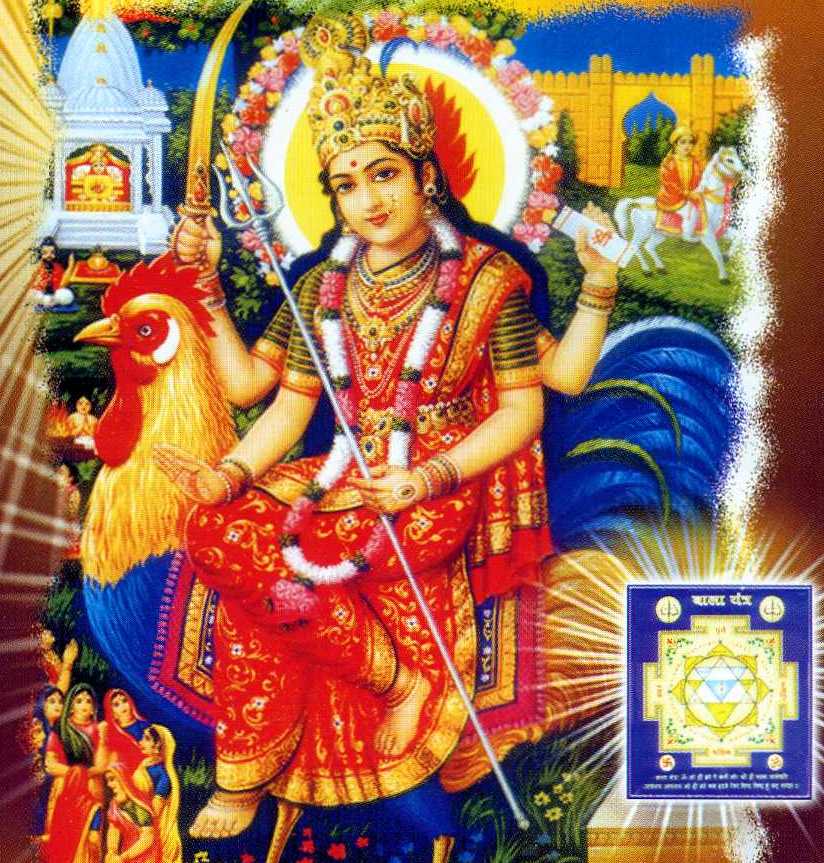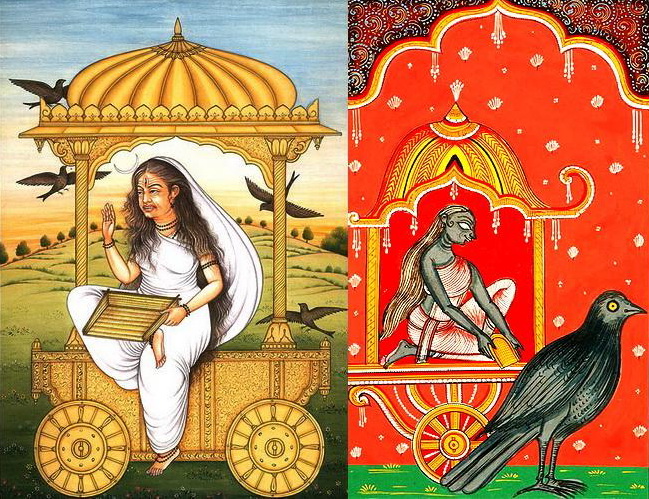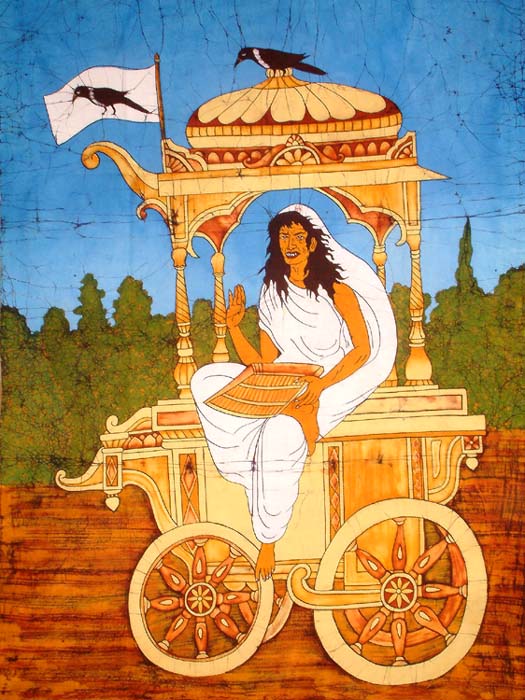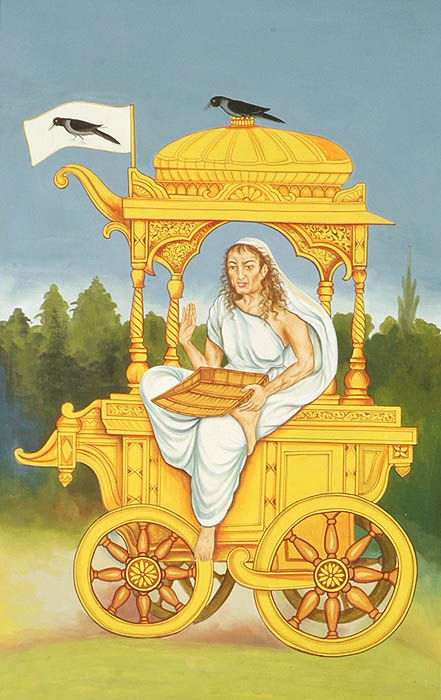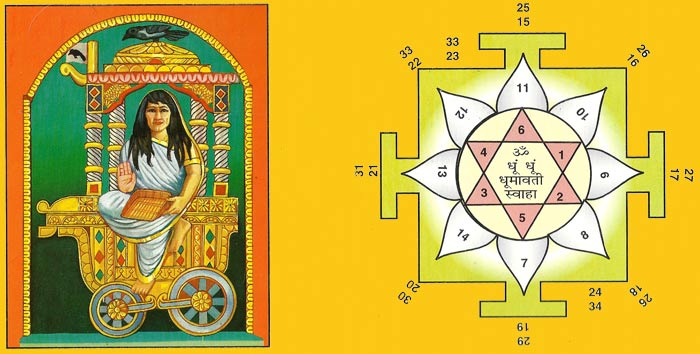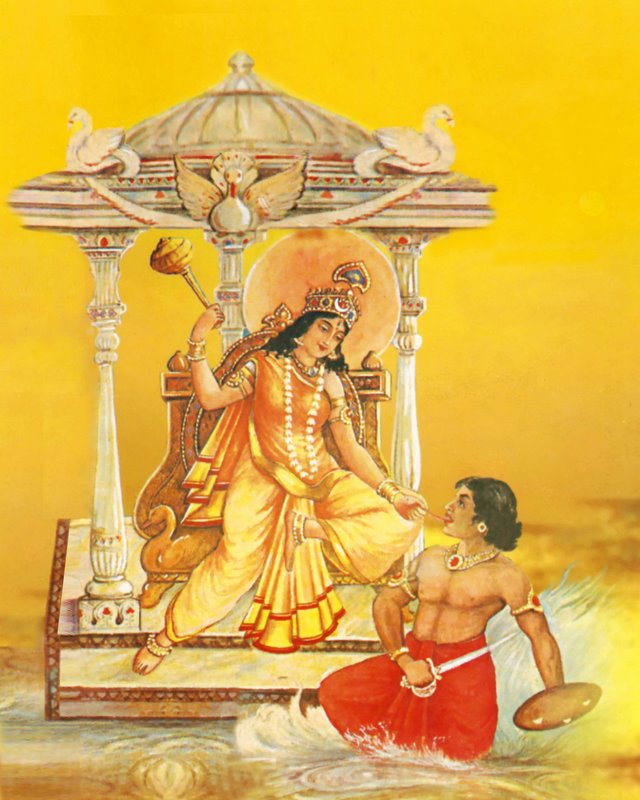Dus Mahavidya Maa Dhumavati
Goddess Ma Dhumavati Devi maintains the seventh significant position among
all the ten Dus Mahavidya's. She is often described in words or sketch
as an old and ugly widow. Goddess Dhumavati's sketch depicts an old
woman causing extreme terror and tormented by great thirst and hunger.
She is associated with things considered inauspicious and unattractive
and is considered to posses' great powers. The goddess is depicted to
ride on a horseless chariot or riding a crow, usually in a cremation
ground in the Chaturmas period.
Goddess Dhumavati is said to provide evidence for or stand as proof of cosmic
dissolution and is "the state of nonexistence" that exists before
creation and after dissolution. Ma Dhumavati's sahastranaam
(thousand-name hymn) relates her both positive and negative aspects. She
is personification of the tamas gun which creates lust and ignorance.
Ma teaches the sadhak to penetrate deep emotionally and intellectually
to seek the inner truths of life. She expresses warmth and affectionate
feeling & bestows boons.
Benefit of Maa Dhoomavati in tantra
In tantra sadhna of Dus Mahavidya sadhaks consider Goddess Ma Dhumavati to
give immediate results and person is protected from all sorts of black
magic, sadness, sorrow, dreadful diseases, tragedy, poverty etc. This
Sadhna evokes innumerable advantages for all round financial prosperity
and stability, blesses with long life. The results are realised
instantly after the accomplishment of the Sadhna.
The aspirant sadhak, having perfected Goddss Ma Dhumavati get all Ashtsidhis,
after which he progresses spiritually and gets the physical energy or
intensity to resque from all troubles, gets all the desires fufilled.
The goddess also blesses her sadhak with ultimate knowledge and takes to
the path of salvation(moksha).
Mata Dhumavati Significance
Sadhna of Goddess Mata Dhumavati requires proper initiation by an able
teacher (Guru) but yet one can attain her blessings by other means of
worship. Goddess Dhumavati is pleased by chanting mantras, doing worship
either on the image, or by the help of Yantras (mystical diagrams) and
by certain rituals and offerings etc. Ones goddess Dhumavati is pleased
then all the aspirations of man gets fulfilled. Ma gives undestructible
Supernatural practices and techniques to the sadhak who wish to defeat
their foes. Sadhna of Ma Dhumavati is considered ideal for bachelors,
widows and for those who wish to renounce worldly and materialistic
pursuits and instead dedicate their entire life towards spiritual
pursuits.
Maa Dhoomavati Puja Benefit
Mata Dhoomavati puja protects a person from the following:
black magic
curse done by others
sadness
grieve
great loss and misfortune
widowhood
death of children
disease
poverty
Shatkarma Prayog By Dus Mahavidya Ma Dhumavati
The biggest benefit in tantric anusthan of dus mahavidya dhoomavati
poojan conducted by vamtantra sadhaks is to obtain the success in the
various forms of shatkarma tantrik prayog(Shantikaran, Vashikaran,
Uchatan, Videshan, Stambhan etc).
Dusmahavidya Mata Dhumavati puja astrological significance
Ma Dhumavati puja is done for Malefic period of ketu or its mahadasa
or antardasa for which affected individual requires immediate remedy to
get relief from the suffering and agony created.
Persons going through the main and sub period of ketu(mahadasha and
antardasha) or having malefic ketu are suggested to carry out vamtantra
Dusmahavidya tantrik Ma Dhumavati puja. This puja is done to mitigate
evil effects of ketu dosha.She is recommended for 'ketu afflictions'
which can be understood as needed to overcome powerful obstacles,
hinderances and ill-fortune.
Dusmahavidya Maa Dhumavati in awakening of kundalini
Kundalini yoga is a spiritual practice and as such spirituality is
contagious. Mantra is chanted(vibrated) to assure the purest inner
guidance during the practice of kundalini yoga.
Ma Dhumavati is associated with the concept to move along the spiritual
path to attain liberation for the awakening of kundalini. "Dhumavati"
means "Terror," or "awe-inspiring," so the one who has achieved the
state of is beyond the fear of death, and therefore awesome.
The Dus Mahavidya Dhumavati mantra is for awakening the kundalini
chakra. On saturday morning if we meditate praying Ma dhumavati and
practice the chant of Dhumavati mata mantra kundalini chakra is
awakened.
Dhumavati mantra
"Om Dhum Dhum Dhumavati Swaha"
Vamtantra also initiate tantrik mantra to the individuals who seek to
learn tantra and for tantra beginners, after proper initiation by sidha
tantrik Guru. Everyone is inspired to do the maximum number of Japa of
Ma Dhumavati mantra "Om Dhum Dhum Dhumavati Swaha" meditating on
Dhumavati ma.
Before chanting the mantras the shri Dhumavati Yantra should be properly
powerised and worshipped. Minimum recitation of the mantra should be
1008 times. Any desire gets fulfilled by the chanting of above mentioned
mantra for 1,25,000 times and by worshipping the Yantra.


%2Bcopy.jpg)
%2Bcopy.jpg)
%2Bcopy.jpg)
.jpg)
.jpg)
.jpg)
%2Bcopy.jpg)
.jpg)
.jpg)
.jpg)
.jpg)
.jpg)
.jpg)
.jpg)
.jpg)
.jpg)
.jpg)

.jpg)
.jpg)
.jpg)
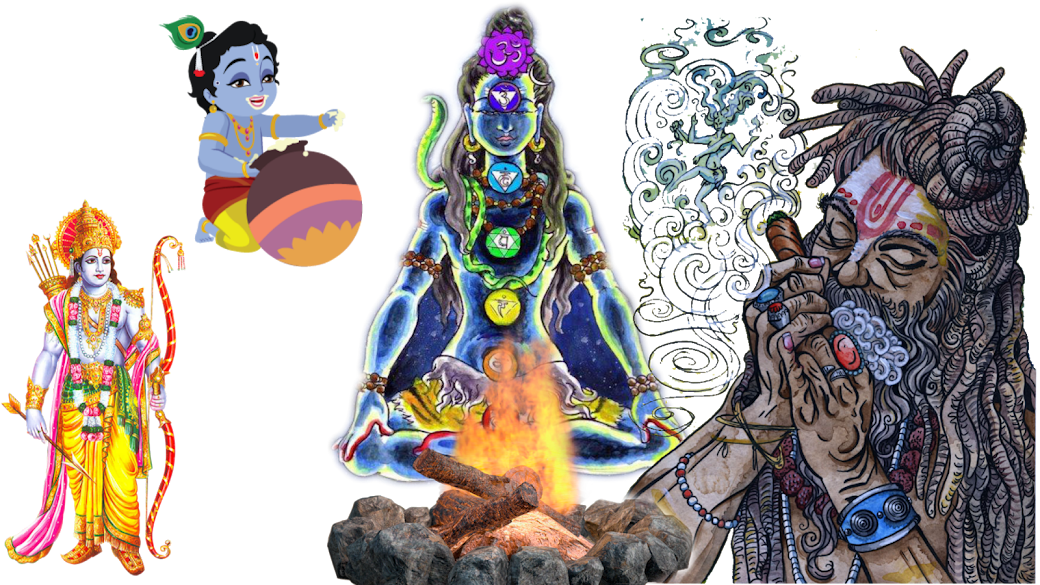
.jpg)
.jpg)
.jpg)





